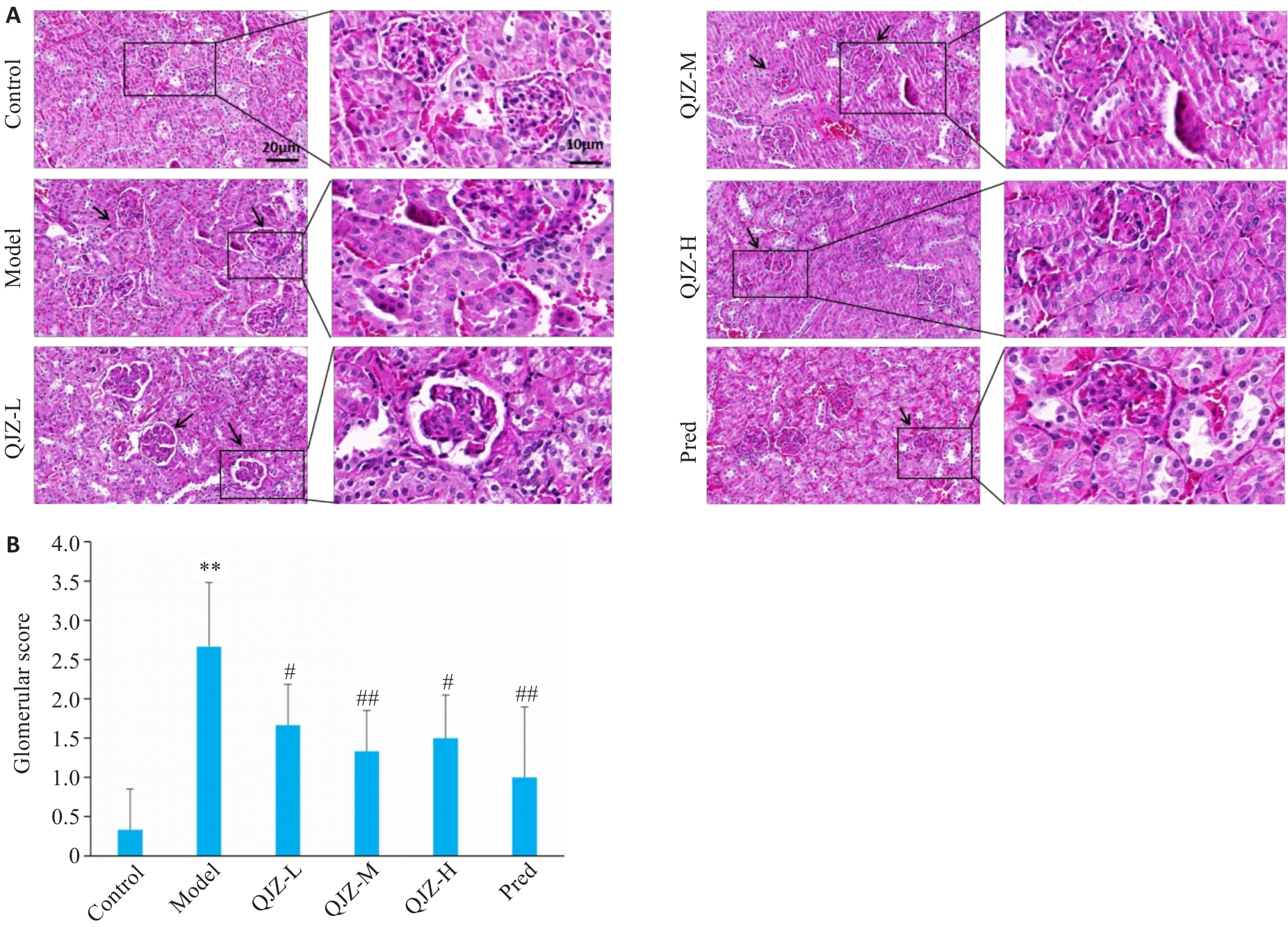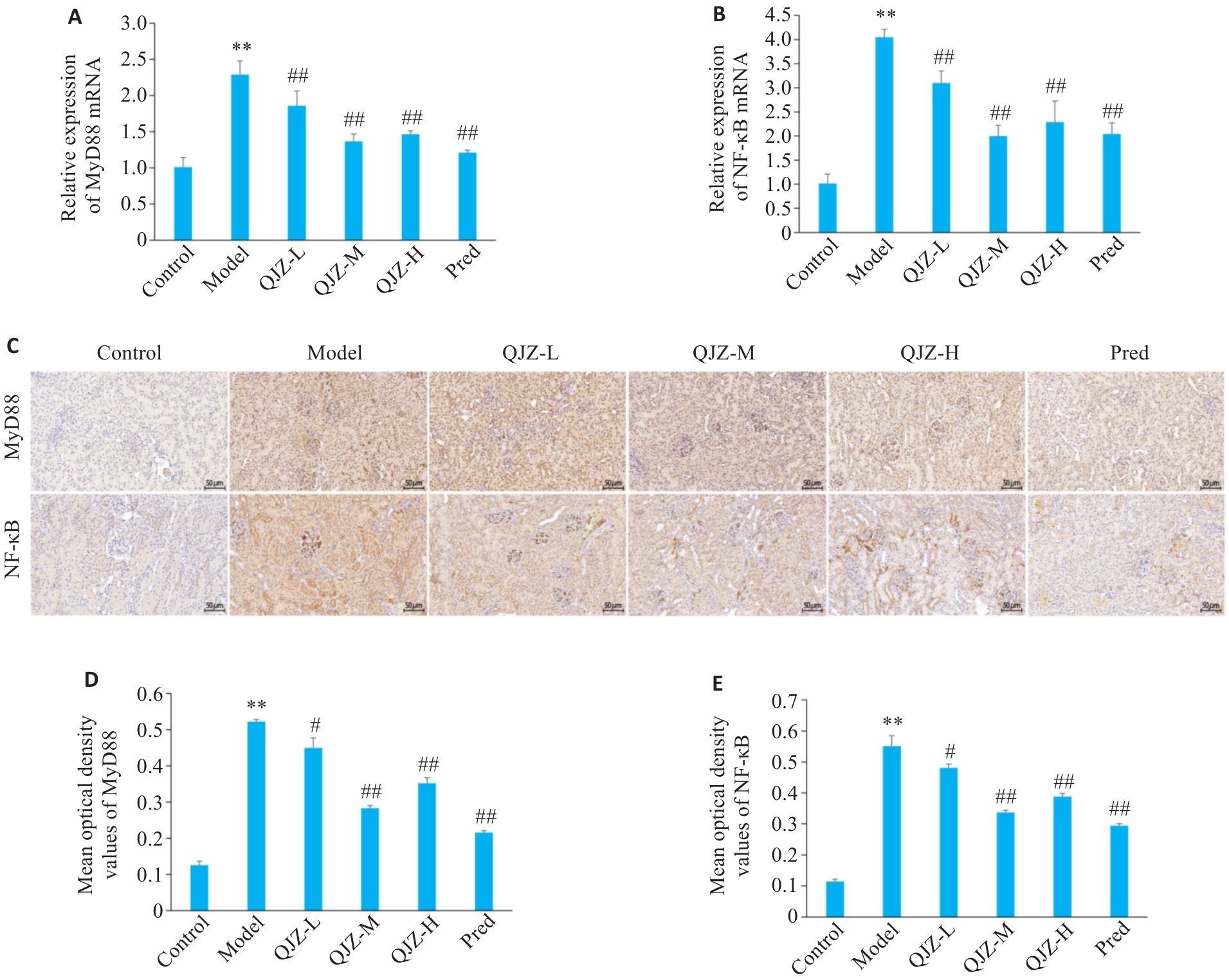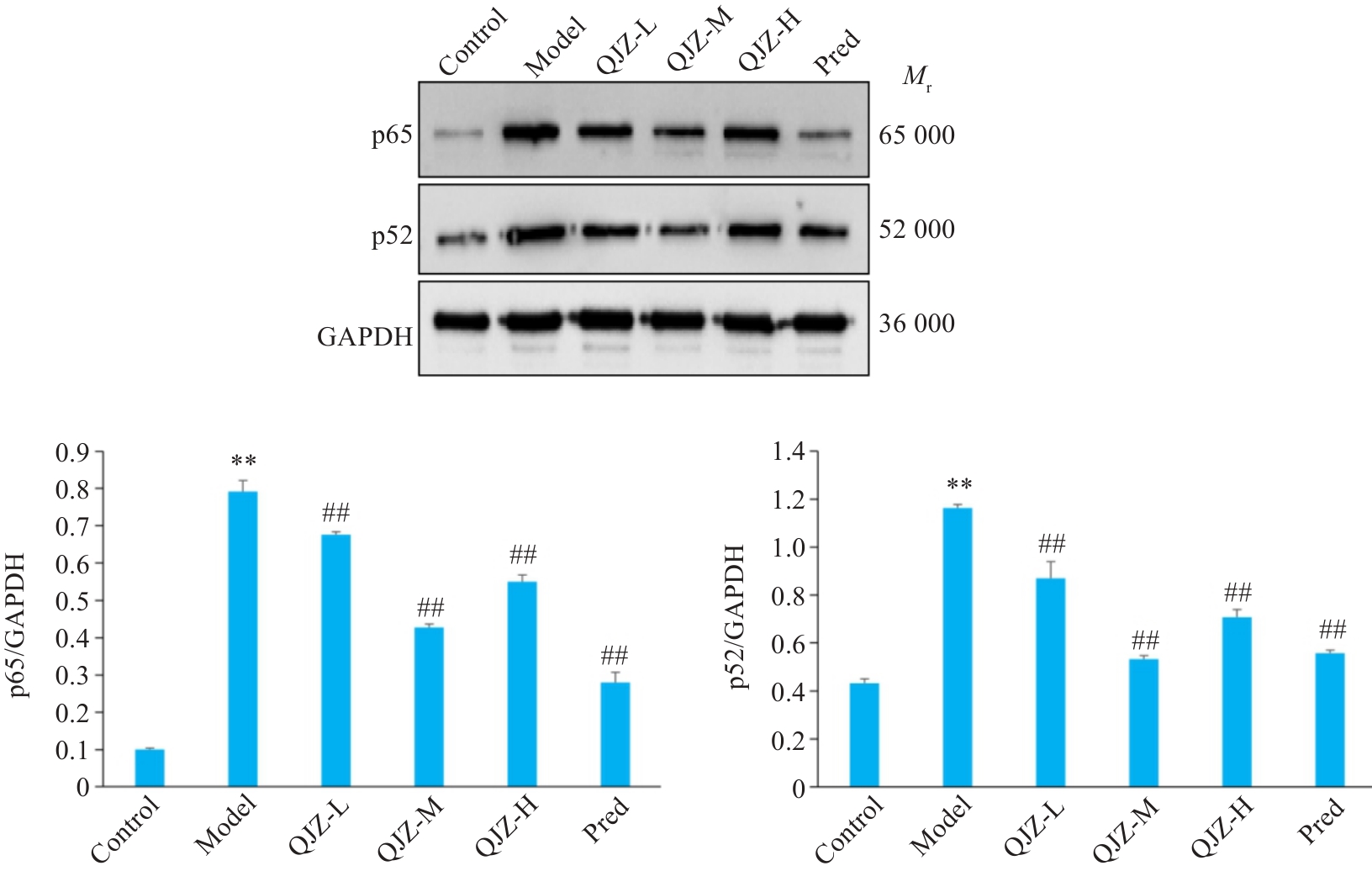Journal of Southern Medical University ›› 2025, Vol. 45 ›› Issue (8): 1625-1632.doi: 10.12122/j.issn.1673-4254.2025.08.07
Zhongfu TANG1( ), Chuanbing HUANG1,2(
), Chuanbing HUANG1,2( ), Ming LI1,2, Lili CHENG1, Junjie CHEN1, Shuangshuang SHANG1, Sidi LIU1
), Ming LI1,2, Lili CHENG1, Junjie CHEN1, Shuangshuang SHANG1, Sidi LIU1
Received:2025-03-06
Online:2025-08-20
Published:2025-09-05
Contact:
Chuanbing HUANG
E-mail:2835192721@qq.com;chuanbinh@163.com
Supported by:Zhongfu TANG, Chuanbing HUANG, Ming LI, Lili CHENG, Junjie CHEN, Shuangshuang SHANG, Sidi LIU. Qihuang Jianpi Zishen Granules ameliorate renal damage in MRL/lpr mice by inhibiting the MyD88/NF-κB pathway[J]. Journal of Southern Medical University, 2025, 45(8): 1625-1632.
Add to citation manager EndNote|Ris|BibTeX
URL: https://www.j-smu.com/EN/10.12122/j.issn.1673-4254.2025.08.07
| Gene | Primer sequence (5'→3') | Length (bp) |
|---|---|---|
| GAPDH | Forward:GCAGTGGCAAAGTGGAGATTG Reverse:CGCTCCTGGAAGATGGTGAT | 169 |
| MyD88 | Forward:TCATGTTCTCCATACCCTTGGT Reverse:AAACTGCGAGTTGGGGTCAG | 175 |
| NF-κB | Forward:GCTCCTGTTCGAGTCTCCAT Reverse:TTGCGCTTCTCTTCAATCCG | 119 |
Tab.1 Primer sequences for RT-qPCR
| Gene | Primer sequence (5'→3') | Length (bp) |
|---|---|---|
| GAPDH | Forward:GCAGTGGCAAAGTGGAGATTG Reverse:CGCTCCTGGAAGATGGTGAT | 169 |
| MyD88 | Forward:TCATGTTCTCCATACCCTTGGT Reverse:AAACTGCGAGTTGGGGTCAG | 175 |
| NF-κB | Forward:GCTCCTGTTCGAGTCTCCAT Reverse:TTGCGCTTCTCTTCAATCCG | 119 |

Fig.1 Effect of Qihuang Jianpi Zishen Granules (QJZ) at low, moderate and high doses (QJZ-L, QJZ-M and QJZ-H, respectively) and prednisone (Pred) on 24-h PRO, UTPCR, and UACR of MRL/lpr mice. **P<0.01 vs Control group (C57BL/6 mice); ##P<0.01 vs Model group. UPCR: Urine protein creatinine ratio; UACR: Urinary albumin creatinine ratio.

Fig.3 Effect of QJZ on renal pathology in MRL/lpr mice (Left, original magnification: ×40; Right,×100).**P<0.01 vs Control group; #P<0.05, ##P<0.01 vs Model group. A: HE staining; B: Glomerular score.

Fig.5 Effect of QJZ on expressions of MyD88 and NF-κB in renal tissues of the mice in each group (Scale bar=50 μm). **P<0.01 vs Control group; #P<0.05, ##P<0.01 vs Model group. A,B:Relative expression of MyD88 and NF‑κB mRNA; C-E: immunohistochemistry results.

Fig.6 Effect of QJZ on p65 and p52 protein levels in the renal tissues of the mice in each group detected by Western blotting. **P<0.01 vs Control group; ##P<0.01 vs Model group.
| [1] | Zhao G, Li X, Zhang Y, et al. Intricating connections: the role of ferroptosis in systemic lupus erythematosus[J]. Front Immunol, 2025, 16: 1534926. doi:10.3389/fimmu.2025.1534926 |
| [2] | Halfon M, Tankeu AT, Ribi C. Mitochondrial dysfunction in systemic lupus erythematosus with a focus on lupus nephritis[J]. Int J Mol Sci, 2024, 25(11): 6162. doi:10.3390/ijms25116162 |
| [3] | Accapezzato D, Caccavale R, Paroli MP, et al. Advances in the pathogenesis and treatment of systemic lupus erythematosus[J]. Int J Mol Sci, 2023, 24(7): 6578. doi:10.3390/ijms24076578 |
| [4] | Zucchi D, Silvagni E, Elefante E, et al. Systemic lupus erythematosus: one year in review 2023[J]. Clin Exp Rheumatol, 2023, 41(5): 997-1008. |
| [5] | Crow MK. Pathogenesis of systemic lupus erythematosus: risks, mechanisms and therapeutic targets[J]. Ann Rheum Dis, 2023, 82(8): 999-1014. doi:10.1136/ard-2022-223741 |
| [6] | 陈少敏, 李红毅, 刘 炽, 等. 基于CiteSpace的中医药治疗系统性红斑狼疮可视化分析[J].新中医, 2024, 56(24): 184-91. doi:10.13457/j.cnki.jncm.2024.24.037 |
| [7] | 朱雅文, 黄传兵, 李 明, 等. 芪黄健脾滋肾颗粒治疗系统性红斑狼疮患者疗效观察及对外周血Toll样受体表达水平的影响[J]. 中医药学报, 2025, 53(2): 67-71. |
| [8] | 钱 爱, 程园园, 朱雅文, 等.芪黄健脾滋肾颗粒治疗系统性红斑狼疮的疗效观察[J]. 安徽中医药大学学报, 2023, 42(6): 7-12. doi:10.3969/j.issn.2095-7246.2023.06.003 |
| [9] | 李 明, 尚双双, 李云飞, 等. 芪黄健脾滋肾颗粒治疗脾肾亏虚型系统性红斑狼疮的临床疗效观察[J]. 时珍国医国药, 2023, 34(2): 370-3. doi:10.3969/j.issn.1008-0805.2023.02.31 |
| [10] | 陈君洁, 黄传兵, 程丽丽, 等. 芪黄健脾滋肾颗粒调控JAK1/STAT1信号通路对MRL/lpr狼疮小鼠足细胞凋亡的影响[J]. 中成药, 2024,46(12): 4145-50. |
| [11] | Baek WY, Choi YS, Lee SW, et al. Toll-like receptor signaling inhibitory peptide improves inflammation in animal model and human systemic lupus erythematosus[J]. Int J Mol Sci, 2021, 22(23): 12764. doi:10.3390/ijms222312764 |
| [12] | Tao B, Xiang W, Li XL, et al. Regulation of Toll-like receptor-mediated inflammatory response by microRNA-152-3p-mediated demethylation of MyD88 in systemic lupus erythematosus[J]. Inflamm Res, 2021, 70(3): 285-96. doi:10.1007/s00011-020-01433-y |
| [13] | Yang Z, Ji S, Liu L, et al. Promotion of TLR7-MyD88-dependent inflammation and autoimmunity in mice through stem-loop changes in Lnc-Atg16l1[J]. Nat Commun, 2024, 15(1): 10224. doi:10.1038/s41467-024-54674-4 |
| [14] | Tilstra JS, Kim M, Gordon RA, et al. B cell-intrinsic Myd88 regulates disease progression in murine lupus[J]. J Exp Med, 2023, 220(12): e20230263. doi:10.1084/jem.20230263 |
| [15] | 吕冬菊, 黄东明, 段伟静. 黄芪甲苷调控HMGB1/NF-κB通路对脓毒症大鼠巨噬细胞极化和急性肾损伤的机制研究[J]. 中国煤炭工业医学杂志, 2025, 28(1): 1-7. |
| [16] | Reynolds JA, Li Y, Herlitz L, et al. Novel biomarker discovery through comprehensive proteomic analysis of lupus mouse serum[J]. J Autoimmun, 2024, 142: 103134. doi:10.1016/j.jaut.2023.103134 |
| [17] | Chalmers SA, Ayilam Ramachandran R, Garcia SJ, et al. The CD6/ALCAM pathway promotes lupus nephritis via T cell-mediated responses[J]. J Clin Invest, 2022, 132(1): e147334. doi:10.1172/jci147334 |
| [18] | Desai SB, Ahdoot R, Malik F, et al. New guidelines and therapeutic updates for the management of lupus nephritis[J]. Curr Opin Nephrol Hypertens, 2024, 33(3): 344-53. doi:10.1097/mnh.0000000000000969 |
| [19] | 尚双双, 李 明, 黄传兵.健脾滋肾法治疗系统性红斑狼疮的理论探源[J].中国中医基础医学杂志,2023,29(04):663-5. |
| [20] | 钱 爱, 黄传兵, 朱雅文, 等. 基于“肾-脾-肠轴” 探讨健脾滋肾法调节肠道菌群治疗系统性红斑狼疮的可行性[J]. 上海中医药杂志, 2024, 58(12): 52-5, 70. |
| [21] | Tian HY, An LZ, Wang PW, et al. Review of Astragalus membranaceus polysaccharides: extraction process, structural features, bioactivities and applications[J]. Chin Herb Med, 2025, 17(1): 56-69. doi:10.1016/j.chmed.2024.09.004 |
| [22] | 张 慧, 罗进辉, 杨 柳, 等.黄芪多糖调节TGF-β1/Smad/AP-1信号通路对慢性肾衰竭大鼠肾纤维化的影响[J].中国老年学杂志, 2024, 44(16): 4040-4. |
| [23] | 陈鲁宁, 胡 扬, 辛国松, 等. 菟丝子化学成分、药理作用研究进展及其质量标志物(Q-Marker)预测[J]. 中草药, 2024, 55(15): 5298-314. doi:10.7501/j.issn.0253-2670.2024.15.029 |
| [24] | Liu ZH, Xu QY, Wang Y, et al. Catalpol from Rehmannia glutinosa targets Nrf2/NF‑κB signaling pathway to improve renal Anemia and fibrosis[J]. Am J Chin Med, 2024, 52(5): 1451-85. doi:10.1142/s0192415x24500575 |
| [25] | Bailly C. Atractylenolides, essential components of Atractylodes-based traditional herbal medicines: Antioxidant, anti-inflammatory and anticancer properties[J]. Eur J Pharmacol, 2021, 891: 173735. doi:10.1016/j.ejphar.2020.173735 |
| [26] | Ding X, Li S, Huang H, et al. Bioactive triterpenoid compounds of Poria cocos (Schw.) Wolf in the treatment of diabetic ulcers via regulating the PI3K-AKT signaling pathway[J]. J Ethnopharmacol, 2024, 325: 117812. doi:10.1016/j.jep.2024.117812 |
| [27] | 施江南, 温乐乐, 江丽洁, 等. 基于文献计量学的覆盆子研究热点与趋势分析[J].中草药, 2025, 56(2): 598-616. doi:10.7501/j.issn.0253-2670.2025.02.022 |
| [28] | 王 平, 孙文娟, 潘保朝, 等. 基于NLRP3通路研究金樱子抑制肾小管上皮细胞间质化治疗糖尿病肾病的作用机制[J].天津中医药,2024, 41(11): 1468-74. |
| [29] | Chen Y, Tian B. IFN-γ promotes the development of systemic lupus erythematosus through the IFNGR1/2-PSTAT1-TBX21 signaling axis[J]. Am J Transl Res, 2022, 14(10): 6874-88. |
| [30] | Richter P, Macovei LA, Mihai IR, et al. Cytokines in systemic lupus erythematosus-focus on TNF-α and IL-17[J]. Int J Mol Sci, 2023, 24(19): 14413. doi:10.3390/ijms241914413 |
| [31] | Bayer AL, Alcaide P. MyD88: At the heart of inflammatory signaling and cardiovascular disease[J]. J Mol Cell Cardiol, 2021, 161: 75-85. doi:10.1016/j.yjmcc.2021.08.001 |
| [32] | Owen AM, Luan L, Burelbach KR, et al. MyD88-dependent signaling drives toll-like receptor-induced trained immunity in macrophages[J]. Front Immunol, 2022, 13: 1044662. doi:10.3389/fimmu.2022.1044662 |
| [33] | Yu T, Xiaojuan F, Jinxi L, et al. Extracellular HMGB1 induced glomerular endothelial cell injury via TLR4/MyD88 signaling pathway in lupus nephritis[J]. Mediators Inflamm, 2021, 2021: 9993971. doi:10.1155/2021/9993971 |
| [34] | Feng X, Yang R, Tian Y, et al. HMGB1 protein promotes glomerular mesangial matrix deposition via TLR2 in lupus nephritis[J]. J Cell Physiol, 2020, 235(6): 5111-9. doi:10.1002/jcp.29379 |
| [35] | Hövelmeyer N, Schmidt-Supprian M, Ohnmacht C. NF‑κB in control of regulatory T cell development, identity, and function[J]. J Mol Med, 2022, 100(7): 985-95. doi:10.1007/s00109-022-02215-1 |
| [36] | Caster DJ, Powell DW. Precision targeting of NF-κB signaling in lupus nephritis[J]. Lupus: Los Angel, 2020, 6(1): 160. |
| [37] | Chen JS, Chen PH, Song YJ, et al. STING upregulation mediates ferroptosis and inflammatory response in lupus nephritis by upregulating TBK1 and activating NF‑κB signal pathway[J]. J Biosci, 2024, 49(1): 9. doi:10.1007/s12038-023-00381-z |
| [38] | He LY, Niu SQ, Yang CX, et al. Cordyceps proteins alleviate lupus nephritis through modulation of the STAT3/mTOR/NF-кB signaling pathway[J]. J Ethnopharmacol, 2023, 309: 116284. doi:10.1016/j.jep.2023.116284 |
| [39] | Su B, Ye H, You X, et al. Icariin alleviates murine lupus nephritis via inhibiting NF-κB activation pathway and NLRP3 inflammasome[J]. Life Sci, 2018, 208: 26-32. doi:10.1016/j.lfs.2018.07.009 |
| Viewed | ||||||
|
Full text |
|
|||||
|
Abstract |
|
|||||